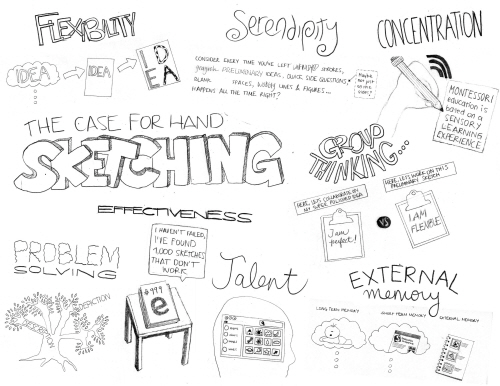Hand Sketches: Things You Didn’t Know Your Doodles Could Accomplish
Everyone seems to have a strong opinion about hand-sketching these days. Some absolutely hate the thought of putting their ideas to paper because they can’t draw to save their lives. Others couldn’t imagine their creativity surviving without it. Love it or hate it, there’s much more to a sketchbook than old-school charm.
Here’s the thing. From personal experience, I know that sketching on paper has something powerful about it that takes my designs to the next level. I’ve spent hours in front of both computer screens and sketchpads, and something about the latter always keeps me going longer, thinking more clearly, progressing further and designing better.
To understand why hand-sketching makes such a difference for me and many designers I know, I did some research. Here’s what I found.
External Memory: Take A Load Off Your Mind, Literally
Cognitive psychologists have been studying the impact of sketching on brain functioning for years, and with good reason: Putting ideas to paper is a powerful way to extend one’s memory. Back in 1972, Allen Newell and Nobel Prize winner Herbert Simon studied long-term memory, short-term memory and — here’s where it gets interesting — “external” memory. They argued that representations such as diagrams and sketches serve our external memory and reduce the burden that we experience when recalling ideas and problem-solving.
Flexibility: Hand Sketches Improve Your Ability To Restructure Ideas
Consider your initial idea for a project. At this point, it exists only in your mind. All of a sudden, you start giving it (physical) shape in what Jill Larkin and Herbert Simon call “external representations.” You’re basically pulling the idea from your mind and recording it somehow. As long as the idea is in your mind, the number of changes and improvements you can mentally process is limited. Your idea won’t get anywhere unless you manipulate and enhance it.
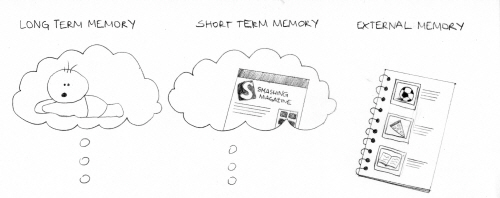
External memory aids, such as sketches and diagrams, can help us overcome the limited capacity of our short- and long-term memories.
Here’s where hand-sketching saves the day: It enables us to externalize our mental images and achieve something that Ilse Verstijnen calls “restructuring.” Verstijnen works in the Psychological Laboratory at the University of Utrecht and has coauthored several articles about the relationship between imagery, perception and sketching.
Restructuring transforms one configuration into another, and in scientific studies, advanced hand-sketchers score highest at restructuring when they are allowed to sketch. In an experiment by Verstijnen, sketchers were shown to be better than non-sketchers at modifying their initial ideas and coming up with novel changes.
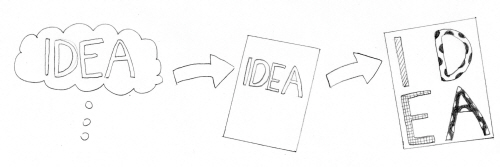
Because of our brain’s limited processing capacity, externalizing our ideas on paper makes it easier to restructure them, transforming the initial structure into a new one.
Another study by researcher Zafer Bilda and his group at Bilkent University in Turkey compared designers’ cognitive processes when sketching on paper versus using software. The study identifies several significant differences: Designers who used paper changed their goals and intentions more frequently and engaged in a higher number of cognitive actions. Changing goals and intentions while sketching is vital because it enables you to pivot your initial idea and to be versatile in your approach.
Interestingly, these results may have less to do with the way we are wired than with the way we have been educated. Can you remember how you first learned to draw, how all of your design courses required physical sketchbooks? That’s right, most of us learned to sketch on paper — and this might actually have affected the way our brain deals with it.
Here comes another buzzword, from our friends in behavioral psychology: conditioning. If paper was one of the first creative stimuli in your life (to the point that, as soon as you saw a blank sheet, you felt the urge to scribble), then it should come as no surprise that your sketching behavior is different on paper than on screen. Regardless of your philosophy of human behavior, we can all agree on one thing: paper has been around far longer than the digital screen.
Don’t get me wrong: Developers of digital sketching devices out there are definitely raising their game and making the lives of many designers easier in exciting, innovative ways. Manufacturers are making the lighting, size and weight of tablets feel unbelievably similar to paper. They’ve come up with ways to make graphic tablets sensitive to stylus pressure and be capable of digitizing paper sketches instantly. As the technology becomes more sophisticated, we can expect better digital sketching experiences. WACOM, a graphic tablet manufacturer, invites sketchers to tag their creations on Twitter with the #madewithwacom hash tag.
Serendipity: Happy Accidents From Unfinished Strokes
When was the last time you sketched a perfect image? It’s safe to say that most of us do not aim for perfection with a pencil and sketchbook. And that is exactly what makes a pencil stroke different from a vector.
Jonathan Fish and Stephen Scrivener authored “Amplifying the Mind’s Eye: Sketching and Visual Cognition,” in which they introduce the idea that “indeterminacies in Leonardo’s sketches elicit mental imagery because automatic mental recognition mechanisms attempt to complete the missing parts and match precepts to memory images.”

Hand-sketching results in inconclusive strokes that open new doors to creativity.
Consider every time you’ve left unfinished strokes, gray ideas over top solid shapes, quick side queries, blank spaces, wobbly lines and figures. Happens all the time, right? These indeterminacies, or “flaws,” which reflect our indecision, are great pointers to new design directions. We lose these when we opt for pixel perfection.
Group Thinking: Connecting Brains Via Hand Sketches
A group of scientists in the Netherlands, led by Remko van der Lugt, observed four idea-generation meetings in which participants used one technique that involved writing and another one that involved sketching. They concluded that sketching stimulates group creativity by enabling individuals to reinterpret their own ideas further and to facilitate other people’s access to those ideas once they are brought to the table.

Collaborating with others in generating concepts is easier when we share sketches that are flexible, unsettled and, thus, full of possibilities.
Not only does hand-sketching improve the idea-generation process, but it provides an effective, visual language that makes it easier for others to understand, comment on and integrate your ideas. This might be even more important in cross-cultural groups, for whom visual sketches can bridge gaps of understanding.
Effectiveness: Better Design Outcomes
Does sketching like a maniac guarantee a better design? The easy answer is no. The subtler answer is that, in certain circumstances, sketching like a mad person could result in a better design. Yes, you read that right.

A useful design mantra is, “I haven’t failed. I’ve just found a thousand sketches that don’t work.”
I ran into this idea while reading one of Maria C. Yang’s studies. She tracked the sketches of a group of engineering students in the idea-generation phase and measured the results according to their final grades and their performance in a contest. She found that the number of concepts that students generated, as evidenced by their sketches, correlated to better design outcomes as long as two things held true: first, the sketches included dimensions and, secondly, the sketches that were significantly tied to the outcome were generated in the first quarter of the cycle (i.e. they were early sketches).
Concentration: Ready, Set, Sketch!
Were you ever in the middle of a major design breakthrough and then were suddenly interrupted? Concentration is key for designers because the creative process is anything but straightforward. The process requires a strong and rare connection between our thoughts, hands and source of inspiration. Its rarity is, indeed, the reason why some of us don’t sleep.
Well, that and deadlines.
There is evidence that sketching aids concentration. Jackie Andrade, of the University of Plymouth’s School of Psychology, tested whether doodling correlated to higher levels of concentration among 40 participants, who tested while taking a telephone call. While we can define doodling as aimlessly sketching patterns and figures unrelated to the primary task, her discovery that it can reduce daydreaming, increase concentration and curb boredom is fascinating.
This helps to explain why some of us find value in carrying our sketchbooks everywhere, pulling them out in the least expected places and in the middle of completely unrelated events.
To recap, sketching stimulates us to a comfortable level — enough to keep us awake, concentrated and engaged. As if this weren’t enough, other studies have found that subjects who consume information on paper were significantly less stressed and tired than those who use screens. Researchers from the University of Gothenburg argued that those who were looking at screens may have been more exhausted because of the “dual-task effect.”
It makes sense. When using a computer, you have to not only complete the task itself, but also figure out your way around the hardware and software. For those of us who learned to sketch on paper, this learning curve feels a lot like stress. For those who are comfortable with graphic tablets and other sophisticated input devices, stress is probably not an issue.
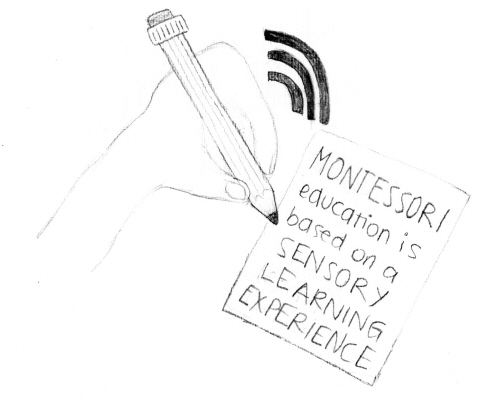
Montessori education encourages children to learn concepts with all five senses.
Some believe that we reach deeper levels of concentration and develop richer concepts when our own hands are the hardware. Regina Rowland, who teaches the “Idea Visualization” course at the Savannah College of Art and Design, has a unique perspective on the matter:
"What I noticed when we moved into the digital world was that exercises all started to look the same. All of a sudden, everybody was designing in Photoshop and the quality of the work started changing dramatically. Before, exercises had a character that was unique in each person. I don’t want to ditch digital; there’s stuff in digital that we could never do by hand. But I do think that when you learn how to experience the world in its visual form, you realize that it is important to have a real, multi-sensorial experience and not an abstracted version of the experience. With digital, you are looking at a screen with 2-D shapes and no interaction. I’ve realized that students who go into a sensorial experience with letters and shapes learn better than those who abstract them. Now, there are nerves in the tips of your fingers, and I believe that when people draw with their hands it makes a different impression in the brain. There are references to this idea in Montessori education: It is through sensorial experiences that you form structures in your brain, and therefore all their activities and teaching tools are things that children have to do with their fingers."
Talent: Enhancing The Graphic Library In Your Mind
What happens when you continually draw and connect symbols as you sketch? What happens when your brain tries to recall shapes that are appropriate to the idea you are trying to externalize? It isn’t hard to see that the better you become at translating imagery from your mind to paper, the more visual resources you will have to draw on and the easier it will be to retrieve them in the future.
Ian Storer, who lectures in the Department of Design and Technology at Loughborough University, came up with this idea of a “graphical library” that designers can combine and restructure to generate concepts. He states in his paper that “creative sketching and designing requires a body of knowledge to base new ideas upon.”
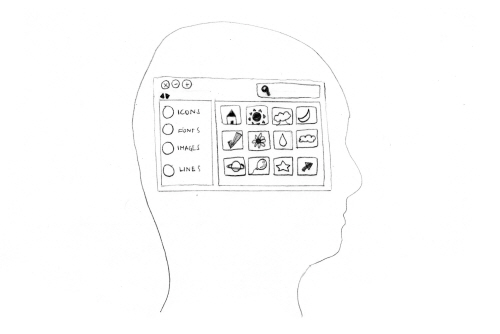
Would I like to nurture a powerful mind for design? Yes, please.
Hand-sketching forces you to access and cultivate a unique visual library in your mind. As much as I love computers, the Internet and the almighty search engine, would I like to nurture a more powerful mind for design? Yes, please.
Problem-Solving: Unlock Solutions With Visual Synthesis
It is fair to say that most of the problems we face as designers are confounding, fuzzy, indeterminate — the types of problems that common logic stumbles on.
I dare anyone to try to solve these types of problems using only simple paragraphs of text. Writing falls short for most design problems. Jonathan Fish explains this brilliantly in his article “Cognitive Catalysis: Sketches for a Time-Lagged Brain.” He compares our design problems to trees whose trunk and branches are vague or abstract descriptions and whose leaves are images that represent “depictive concrete thought.”

Jonathan Fish explains that our design problems are like trees whose trunk and branches are abstract (usually textual) descriptions and whose leaves are concrete depictions (i.e. images). Most design solutions aim to reconcile these.
He goes on to explain that when you try to solve a design problem that is full of uncertainties, “both description and depiction are interdependent.”
Niall Seery and his colleagues at the University of Limerick propose the best definition of sketching that I’ve ever read:
"Sketching is a sense-making tool which supports the synthesis of visual imagery."
Ready to improve your flexibility, serendipity, group thinking, effectiveness, concentration, talent and problem-solving? The eight benefits we’ve covered here may be just a few sketches away!
Further Reading
- I Draw Pictures All Day
- How To Get Started With Sketchnotes
- 50 Clever Tutorials and Techniques on Traditional Drawing
- 100 Free Hand-Drawn Doodle Icons


 Flexible CMS. Headless & API 1st
Flexible CMS. Headless & API 1st



